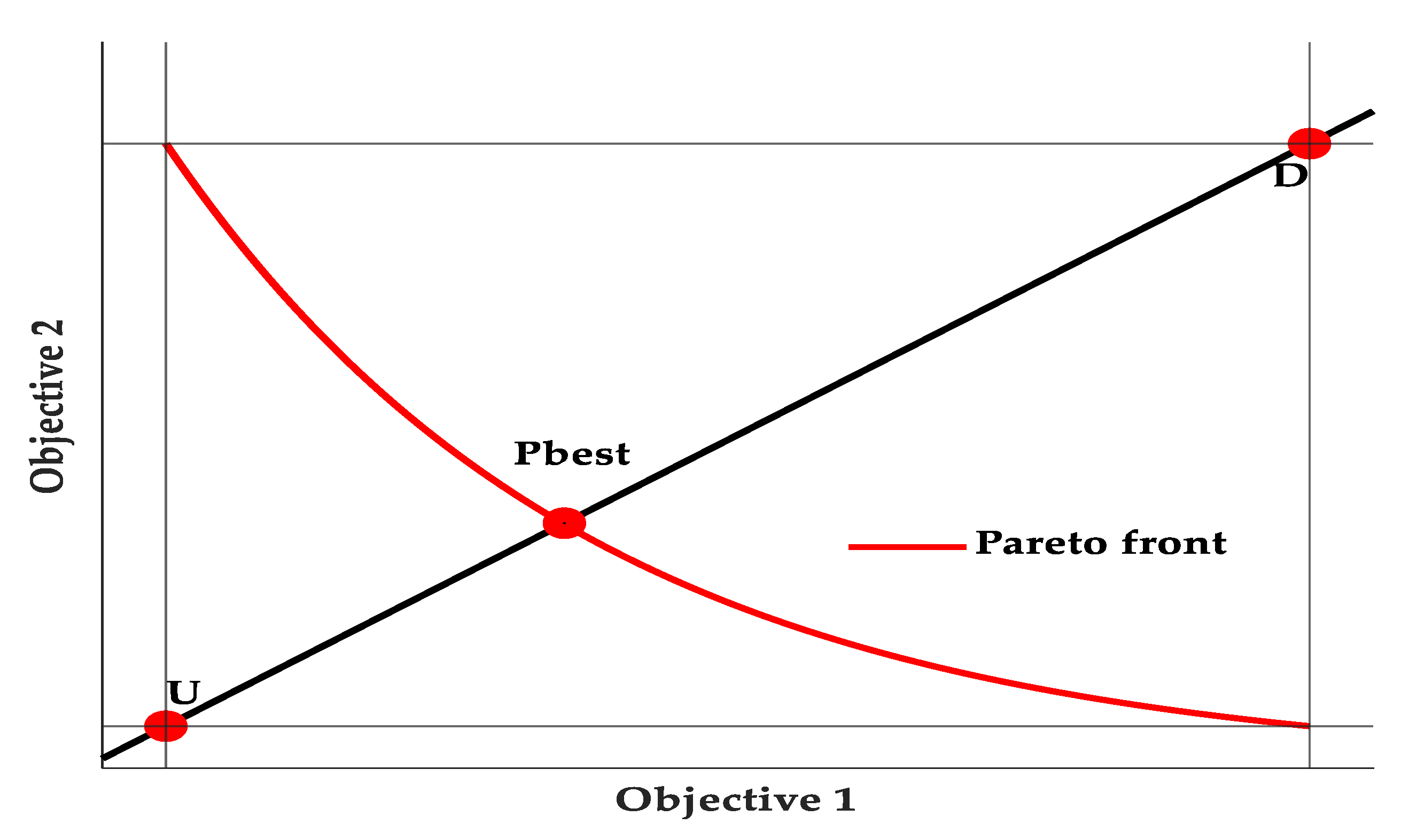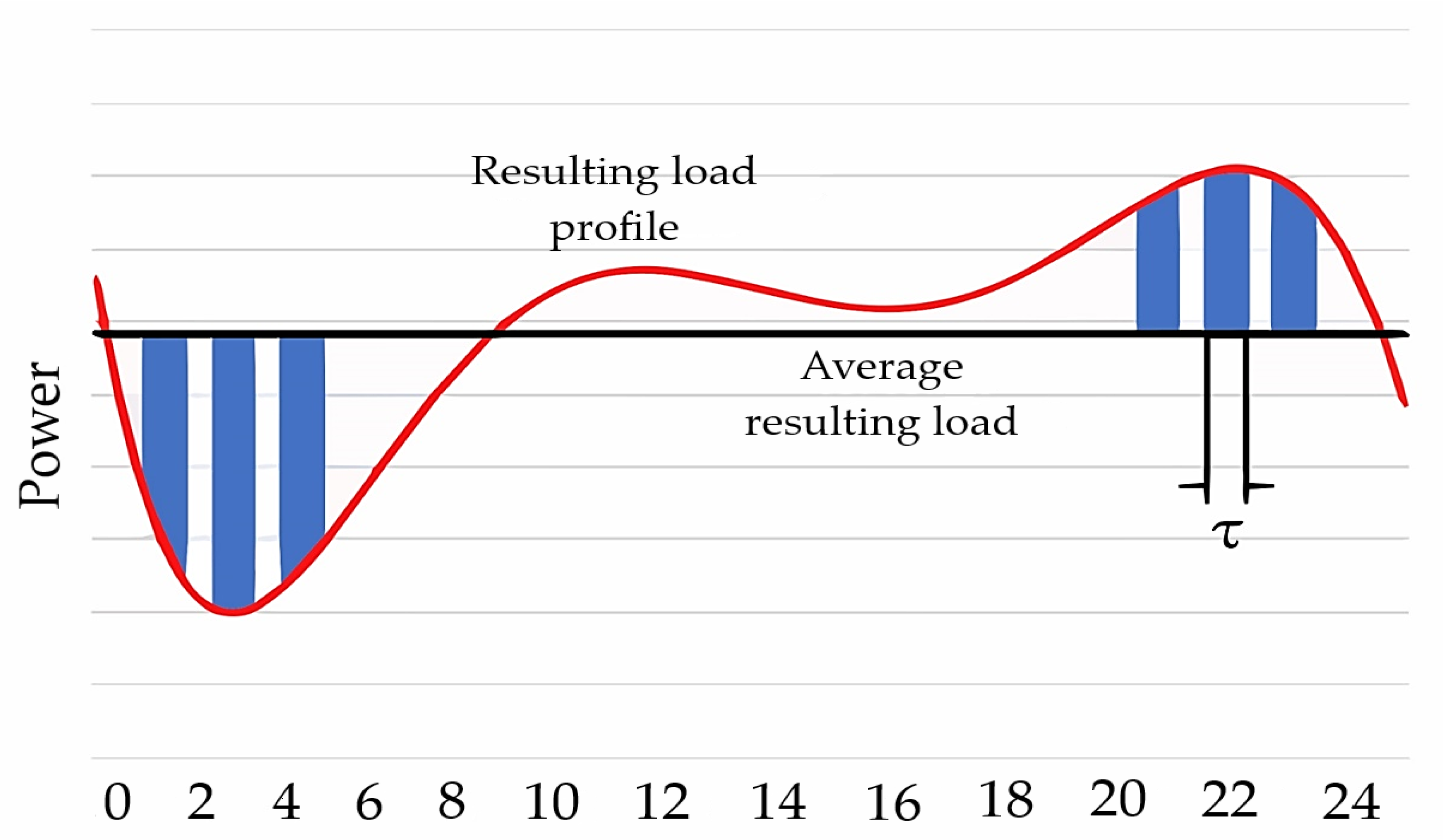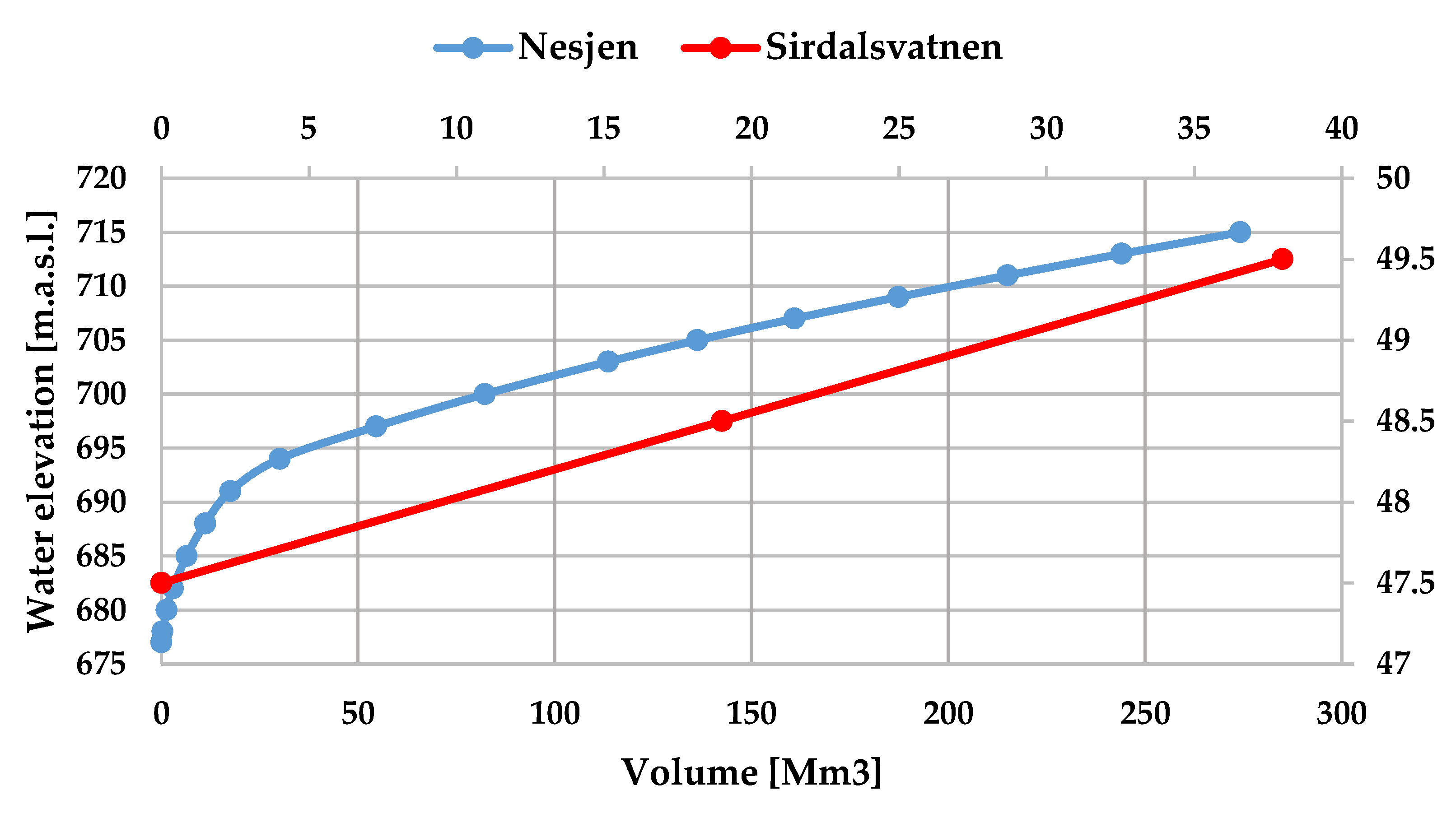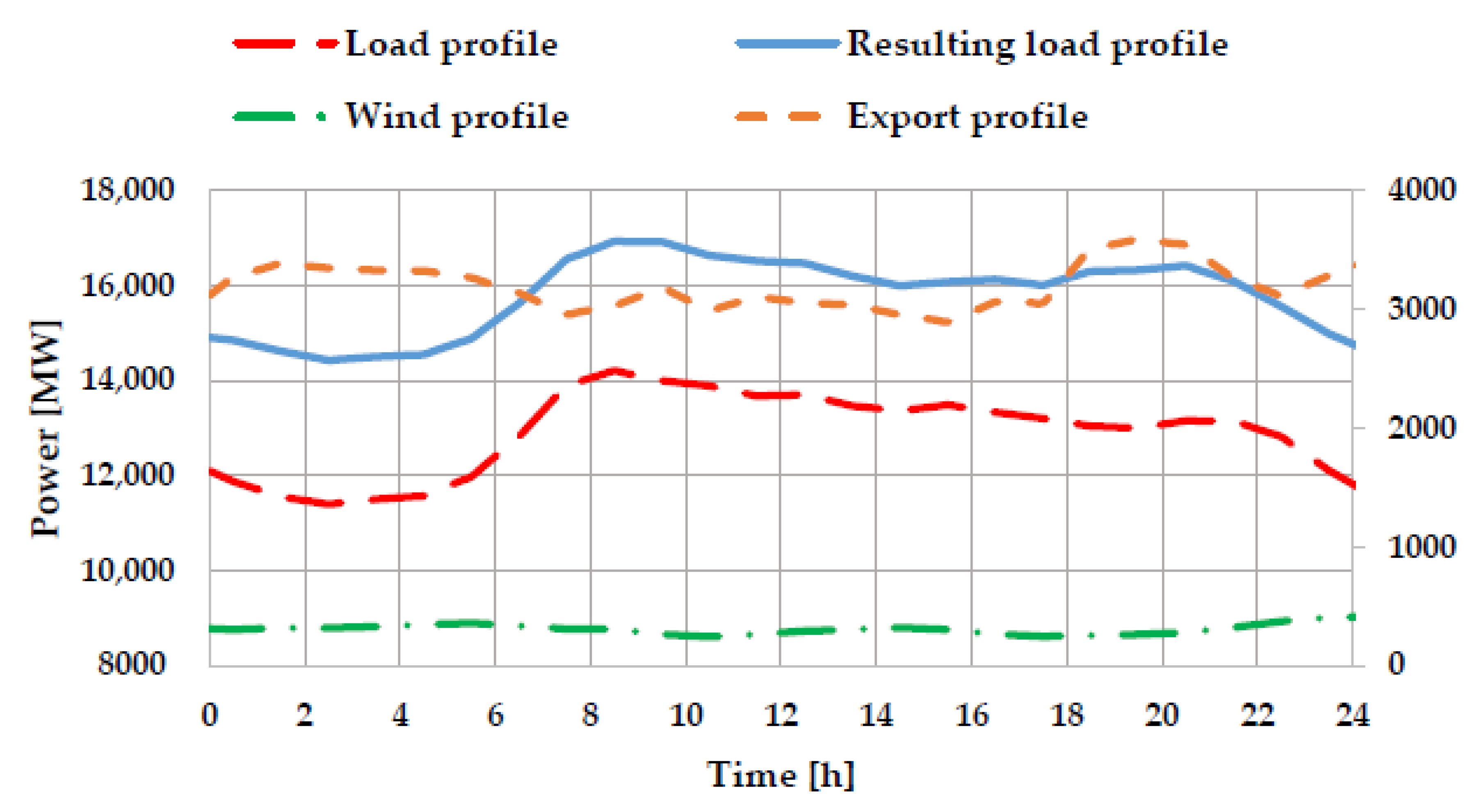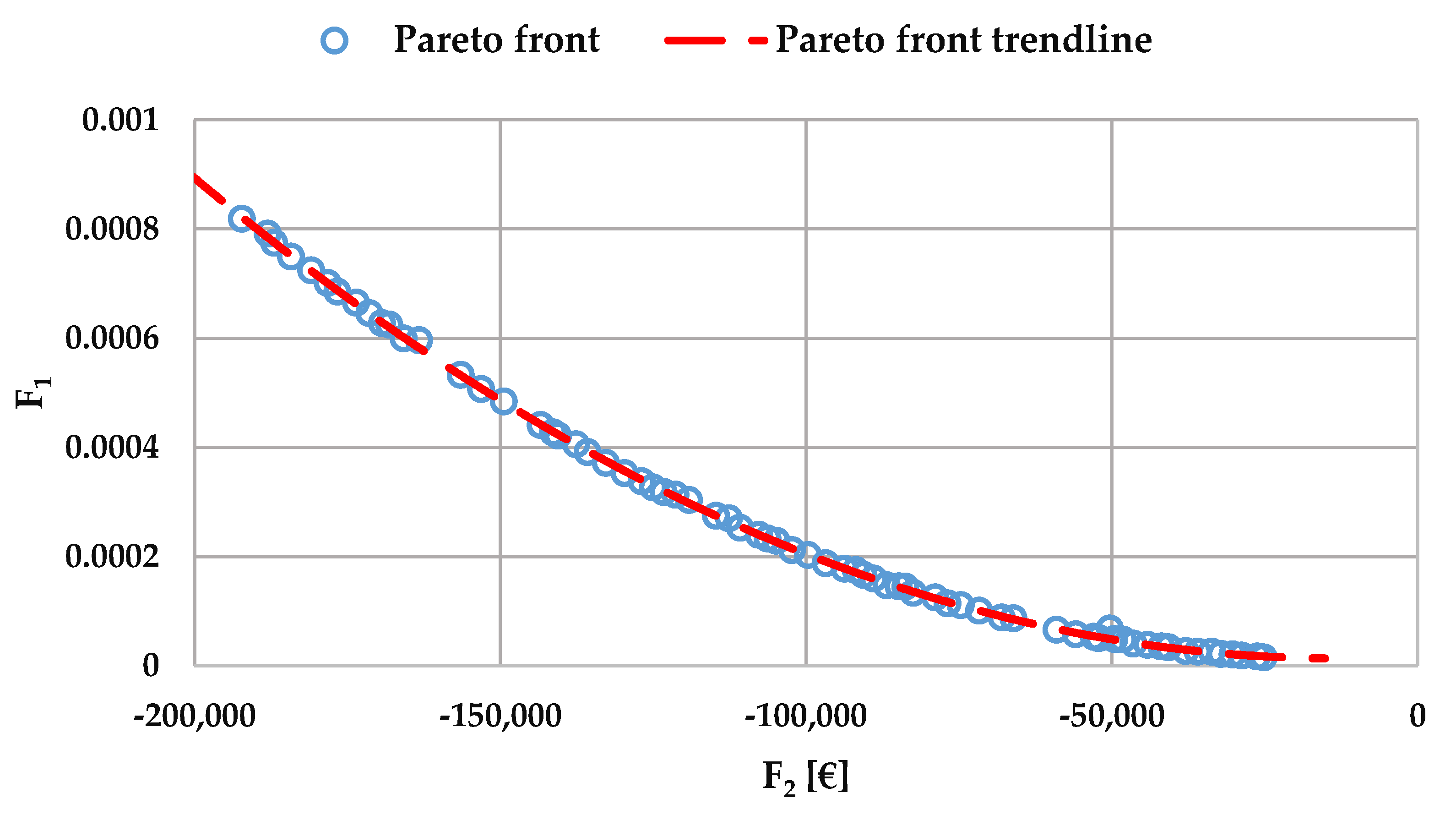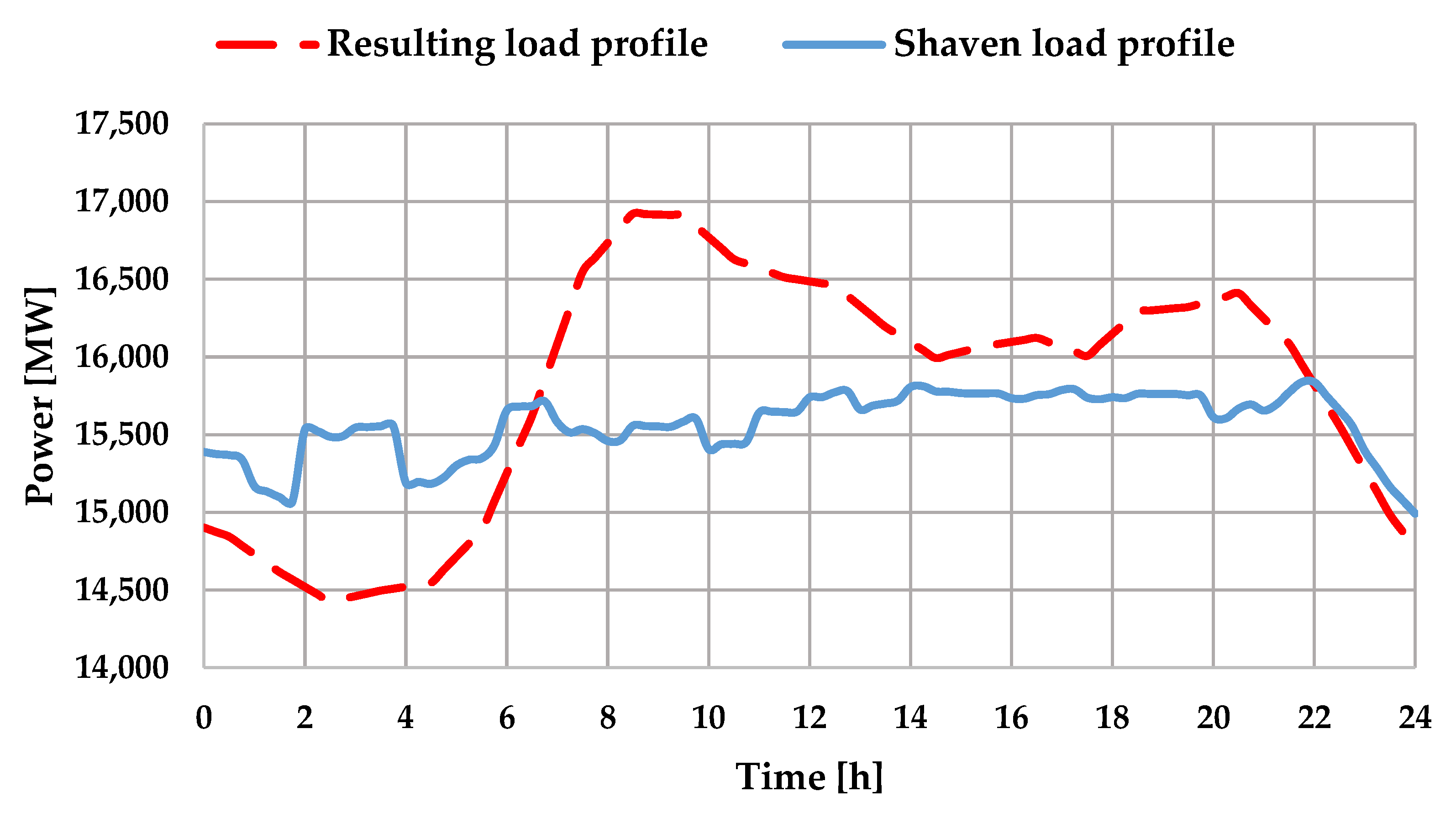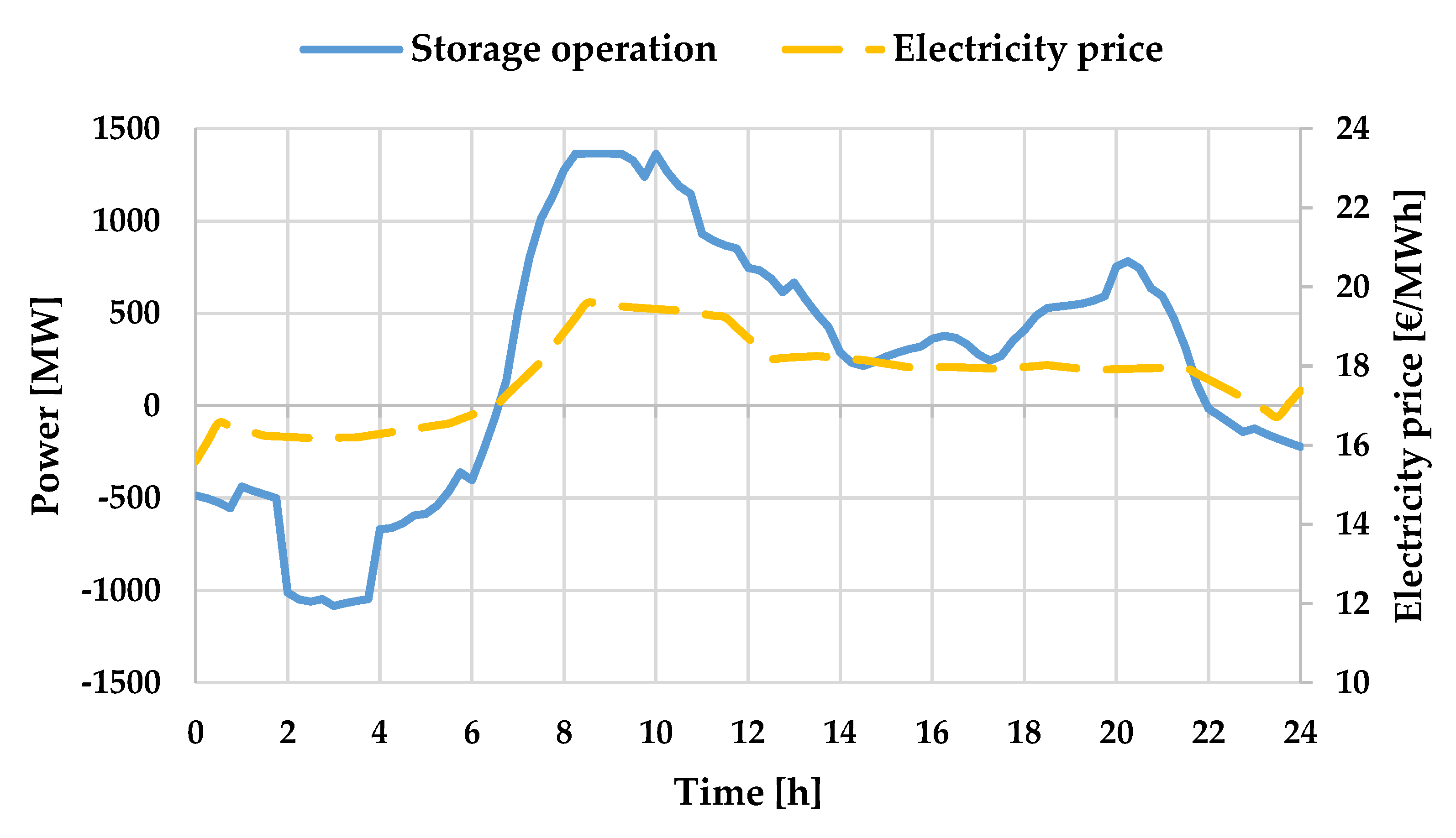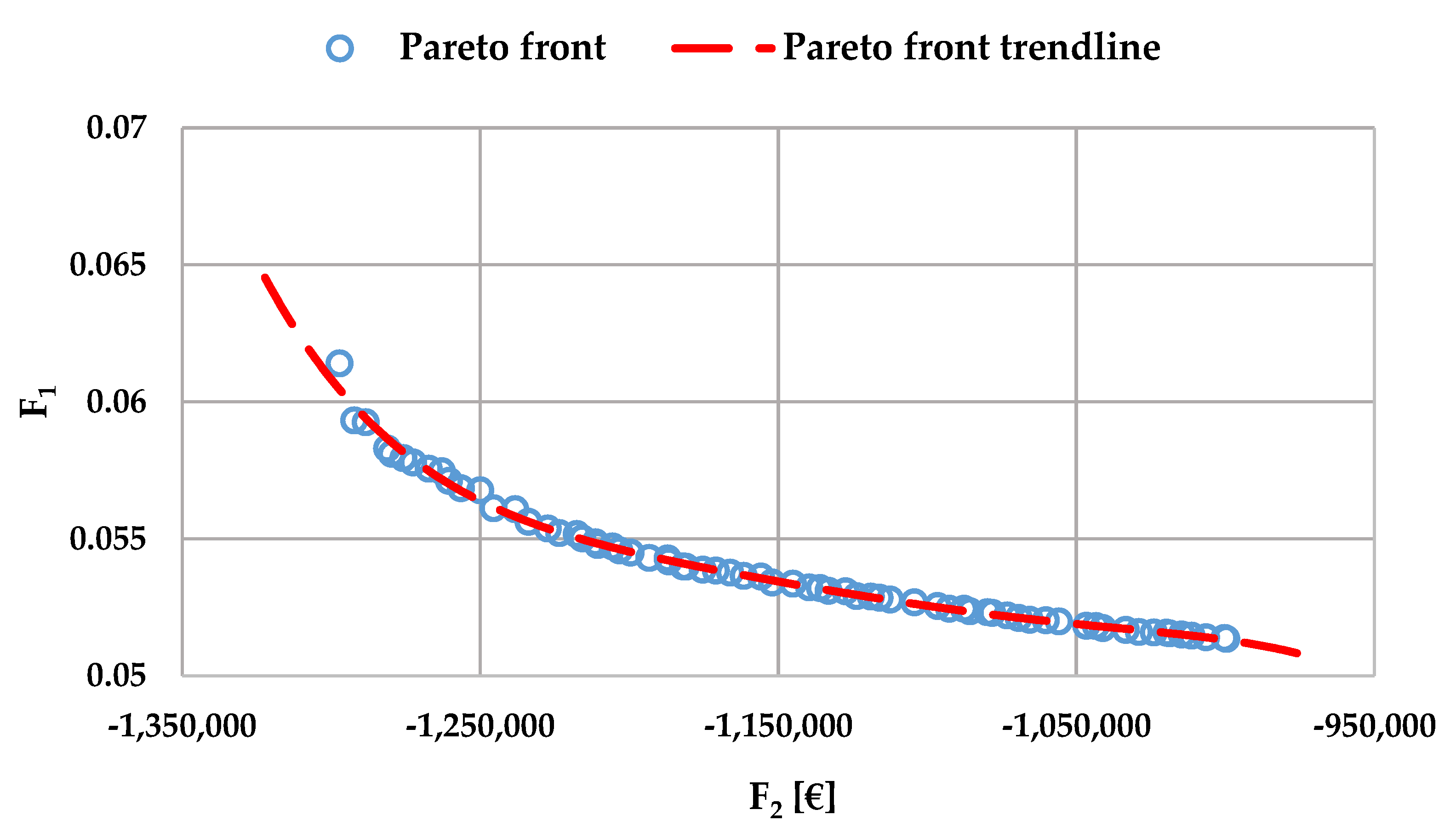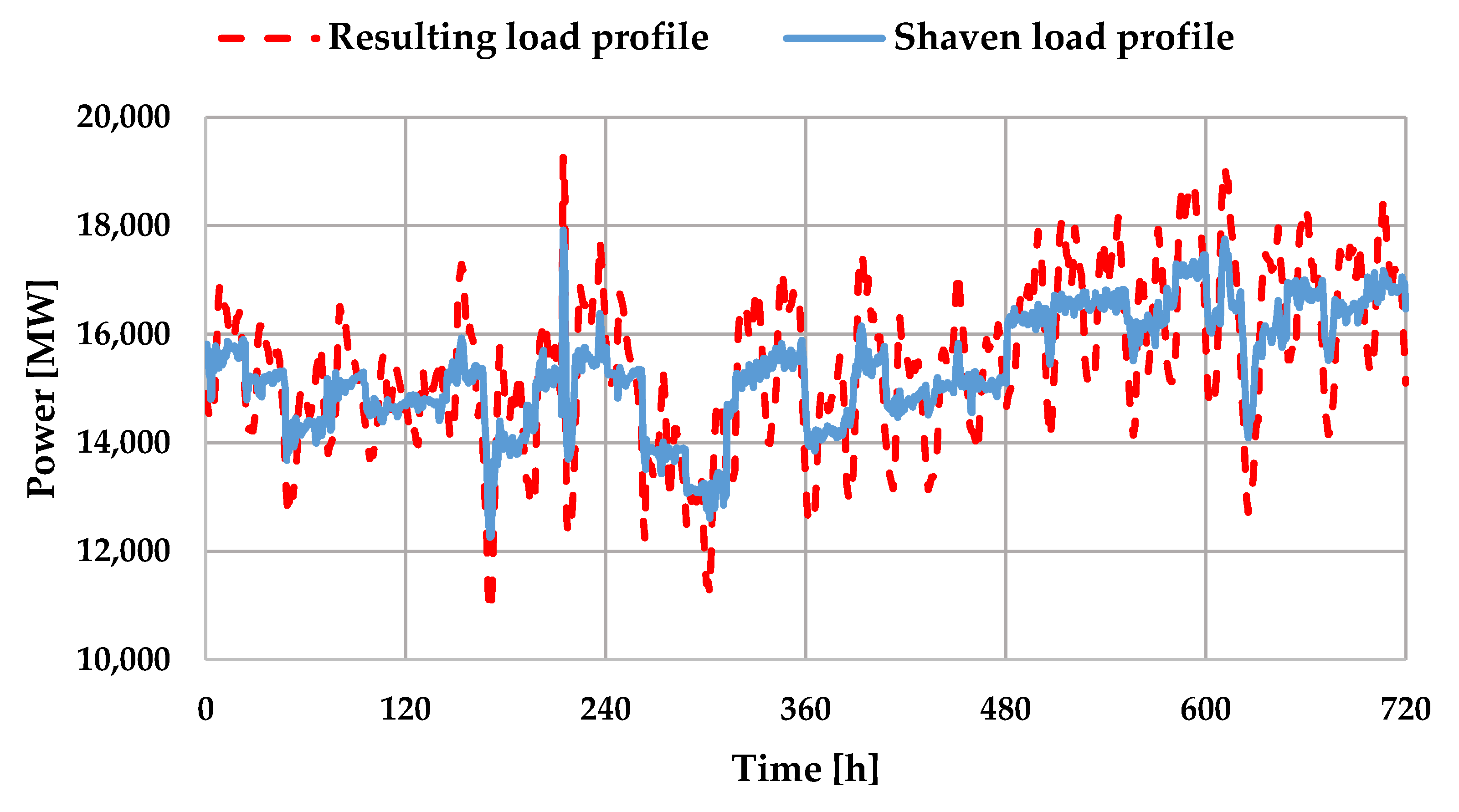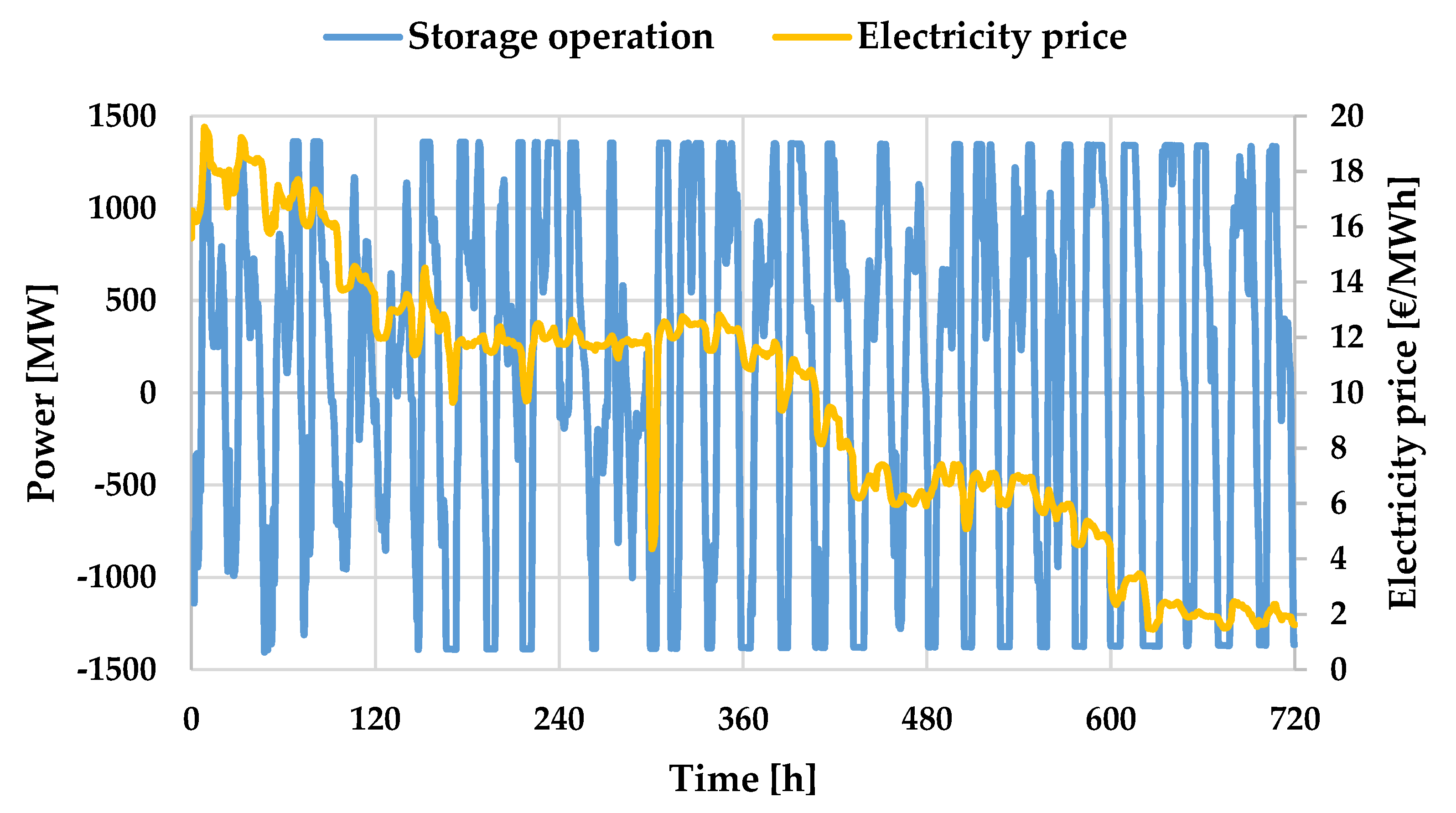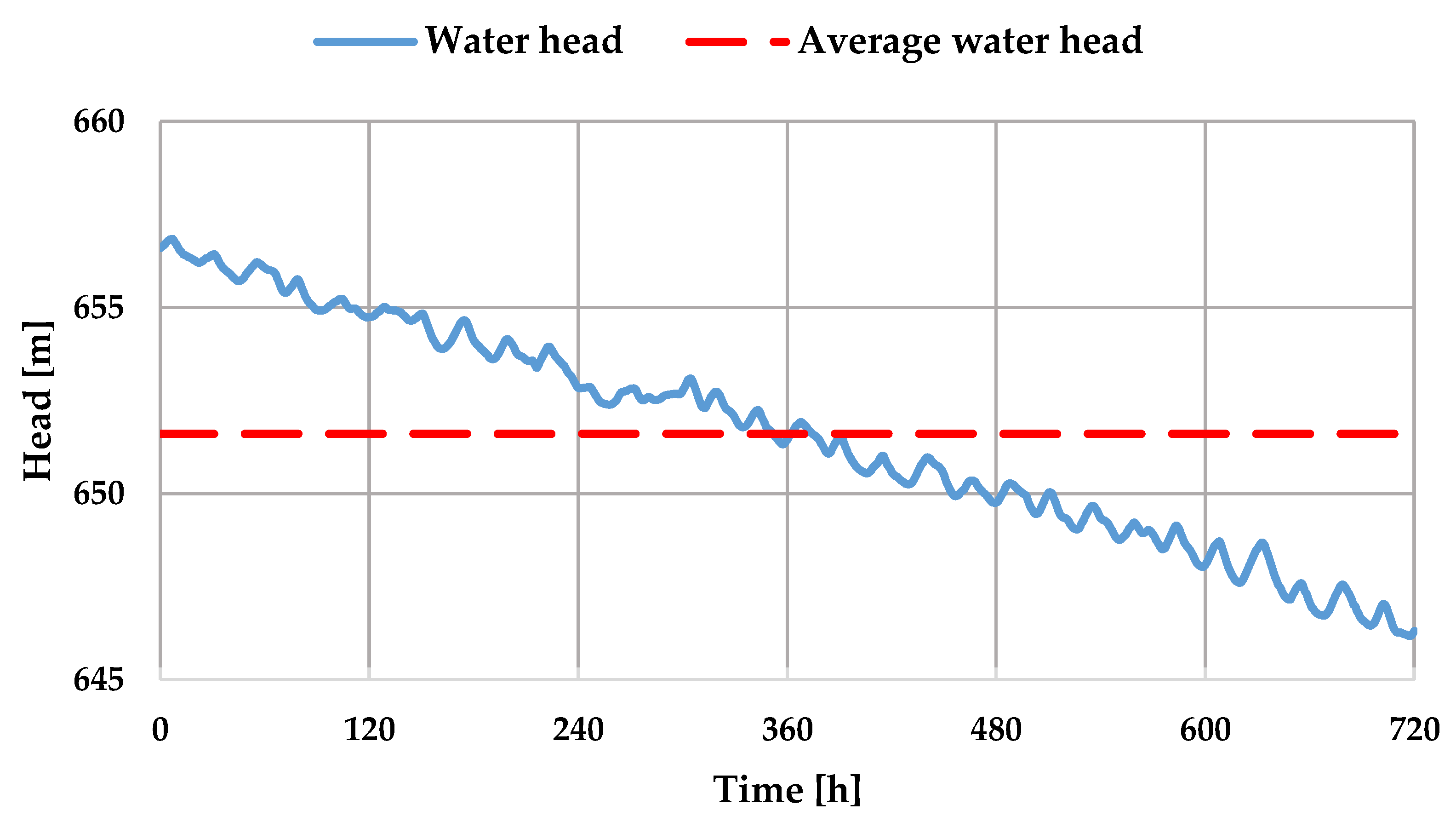1. Introduction
One of the fundamental problems in power system operation is maintaining the balance between generation and consumption. The disruption of this balance entails frequency oscillations, voltage fluctuations, and in the worst-case scenario, it can jeopardize the power system stability and lead to partial or complete blackouts. Maintaining the balance between generation and consumption is especially challenging during peak hours. As a consequence of the constant growth in the number of consumers, the peak load in the system is also growing, so the peak load management problem is becoming more and more important.
The commonly used approach in addressing this problem lays in the use of gas and diesel engine power plants, however, these units are characterized by high operating costs and they are not in compliance with modern environmental protection aspirations [
1,
2]. On the other hand, the presented issue may be treated through peak load shaving, sometimes referred to as load leveling. Namely, peak load shaving represents the process of eliminating the peaks and the valleys from the daily load profile making it as close as possible to the average daily load. The benefits of peak load shaving, both for the grid operator and for the end-users, are various and have been elaborated in a large number of studies [
3,
4]. Thus, different strategies for peak load shaving are being developed and a large number of these strategies are currently in use.
Three different strategies for peak load shaving, which have been thoroughly reviewed in literature and implemented in practical power systems, involve the integration of energy storage system (ESS), smart use of the vehicle-to-grid (V2G) technology, and demand side management (DSM). Electric vehicles (EVs) have not been widely deployed yet, especially in undeveloped countries, and since a single EV is incapable of meeting the peak demand alone, a large number of EVs needs to be synchronized to implement the V2G technology efficiently, which in itself represent a challenging task [
5]. In [
6,
7], the authors have laid out two interesting operation strategies for peak shaving on a residential level, the first focusing on smart households with high potential for demand response and the latter focusing on four specific appliances which can be controlled without jeopardizing the customer’s comfort. However, implementation of DSM implies the use of advanced information and communication technologies (ICT) which are only partially implemented in undeveloped countries. Therefore, to bridge the gap between present and modern power systems and aid the ongoing energy transition process, ESS is proven to be the only reliable option.
The development of storage technologies is one of the most challenging fields of research in electrical engineering. The current research in this area is mostly directed towards battery energy storage systems (BESS). In [
8], the authors have developed a linear programming-based method for optimal sizing and operation of BESS for peak shaving in industrial applications to minimize the electricity costs. The same problem, without taking into account the battery degradation, has been solved using dynamic programming in [
9]. In contrast with the work done in these papers, which is based on conventional problem-solving techniques, in [
10], the authors have developed an analytical method for determining the optimal peak shaving strategy with its main disadvantage being the need to numerically search for the peak shaving threshold, which makes the procedure computationally expensive. Although all of the relevant studies proved the benefits of deploying BESS, they have a short lifespan, require additional maintenance infrastructure, and have limited power output, so they can only be used for peak shaving in the distribution grid.
The high penetration of renewable energy sources (RES) has placed high demands on technologies that provide additional operational flexibility, with bulk energy storage such as pumped hydroelectric energy storage (PHES) and compressed air energy storage (CAES) coming to the forefront. Although expected to provide promising results in the future, CAES technology is still in the early stage of development [
11]. For that reason, in this paper, we have investigated the possibility of using PHES, as a widely deployed storage technology, for the improvement of power system flexibility.
Because of the high investment costs associated with pumped hydro installations, the storage itself needs to be operated economically within its technical limitations to ensure its revenue. One of the most important sources of revenue for storage technologies is the electricity price arbitrage. In the traditional power sector, characterized by a significant electricity price spread throughout the day, the financial revenue of the storage technologies was almost certain. However, the transition to renewable energy sources, along with the liberalization of the electricity market has led to large fluctuations in the electricity price on an annual basis, with a large number of days being characterized by insignificant price spread. Achieving optimal techno-economical operation of the PHES under these circumstances has become a major issue, resulting in a large number of scientific papers treating similar thematic.
In [
12], the authors have developed three simple, yet very efficient strategies for practical operation of the PHES using electricity price arbitrage and used it to estimate the revenue of the test storage in different electricity markets, however, the technical limitations of the PHES have not been taken into account. The model developed in [
13] is based on the Monte Carlo optimization, and the authors have successfully used it to determine the maximal potential revenue from electricity price arbitrage for several different storages, where the model is developed in such a way that it allows for the technical constraints to be implemented. In [
14], the authors have developed an optimal operation strategy for cascade hydropower plants accompanied by pumped hydro storage by optimizing its participation in the ancillary services market. Instead of determining the optimal operation of the storage to maximize its revenue, in [
15], the authors have inspected different financial mechanisms to ensure the economical operation of future PHES projects in Croatia.
In addition to presenting the fundamental characteristics of the PHES, recognizing peak load management and economical operation of the PHES as two important issues awaiting their solution, this paper presents a novel operation algorithm aimed at economically feasible peak shaving utilizing PHES. In contrast with most of the previous studies, the proposed model implies fewer assumptions, and presents a realistic image of the PHES, allowing a wide variety of different parameters to be taken into account, some of them being: seasonal inflow variations, rainfall, evaporation, flow and water head constraints. The proposed operation algorithm can be applied to different configurations of power systems and various energy mixes coupled with various wholesale market conditions. Apart from that, the proposed methodology can be easily modified and used for economically feasible peak shaving utilizing different storage technologies, implying the universality of the proposed approach. The proposed operation algorithm is used to analyze the potential revenue of the Tonstad PHES and to analyze its benefits to the Norwegian power system, where PHES is shown to live up to its high expectations as a facilitator of renewable energy. Furthermore, a significant connection between the electricity price spread and the revenue of the storage is proven, where some of the possible problems regarding the uncertainty of the revenue have been addressed, providing possible future solutions.
2. Fundamental Characteristics of the PHES
Pumped hydroelectric energy storage is a type of storage which stores energy in the form of the gravitational potential energy of water, pumped from a lower to the higher elevation reservoir, as shown in
Figure 1.
During the peak hours, the stored water is released through the turbine from the upper reservoir and used to generate power. On the other hand, during the periods of low demand, excess generation capacity in the system is used to pump water from the lower to the higher elevation reservoir. Through this simple concept, energy is transferred from the peak part of the daily load curve to the base, thus flattening the load curve.
The first application of PHES dates back to the early 20th century, and the units which were used were conventional synchronous-speed units. Then, in the late 20th century, Japan’s utilities chose to install variable-speed pumps so that the plants could also help stabilize the grid frequency because the variable-speed induction motor-generators can adjust the plants charging and discharging to simultaneously balance electricity generation and load demand [
16]. These units provide wider operating range in generation mode, because of the possibility to optimize operating efficiency by adjusting the speed. On the other hand, conventional single-speed units in pumping mode can only operate with constant power, while variable-speed units can operate within a wide range, thus allowing them to store excess energy from various sources. Although variable-speed units have higher capital costs, the benefits they provide for the power system flexibility could make them a crucial resource for balancing modern power systems [
17].
All pumped hydroelectric energy storages can be classified as closed or open-loop systems. While open-loop PHES is continuously connected to a naturally-flowing water source, closed-loop systems are usually preferred because of the fewer environmental impacts associated with their construction. In general, open-loop pumped hydro storages provide more flexibility, because they have a constant inflow throughout the year.
3. Power System Model
The power system model utilized in this paper is an aggregated model which represents the power system as a single point with concentrated generation and consumption. The proposed model at all times satisfies the power balance equation:
where
represents the aggregated generation in the system,
and
represent the exchange with neighboring countries,
represents the aggregated load in the power system, and
represents the power losses due to transmission and distribution.
The main justification for this model is that the aggregated model eliminates the need for power flow analysis, being a time-consuming process for large-scale power systems which can yield additional problems related to unreliable convergence. Apart from that, it can be universally applied to various configurations of power systems and various energy mixes in the system. However, the main disadvantage of the proposed model is that the power system operating constraints are not taken into account. In other words, it is assumed that the power system is robust and well developed, so that the storage operation does not lead to congestion problems and voltage deterioration in the system.
One of the main goals in modern power systems is to use the available resources to facilitate and maximize the use of electricity generated from renewable energy sources while also meeting all the technical, market and regulatory constraints. The main obstacle to meeting this goal lays in the volatile nature of renewable energy sources, which additionally emphasizes the problem of maintaining the balance between generation and consumption. The remaining generation capacities in the power system, apart from meeting the time-varying demand, also need to smooth out the fluctuations in the production of renewable energy sources, so the resulting load profile which can be seen by the conventional generation capacities in the system can be determined as:
where
denotes the aggregated production of various types of renewable energy sources.
The resulting load profile shows the mismatch between the peak demand in the system and the generation of renewable energy sources which leads to large fluctuations in the overall system load. This problem is particularly pronounced in power systems with high penetration of solar power plants, where the mismatch between the peak demand and the peak production of solar power plants leads to the creation of the so-called “duck curve”, which is considered to be one of the main drawbacks of solar power. After sunset, the available generation capacities need to rapidly increase their production in order to meet the demand increase accompanied with sudden decrease in the production of solar power plants. This puts additional stress on the equipment which in the end decreases the power system efficiency.
The resulting load profile defined in this way is used as a basis for the storage operation algorithm described in the next section which aims to reduce the fluctuations in the system demand and alleviate the stress on the remaining generation capacities.
4. The Proposed Algorithm for Peak Shaving
The starting assumption for the analysis is that the forecast of the variables that appear in the Equation (2) is done in advance, meaning that the resulting load profile is predefined.
Let the 24-hour interval be uniformly divided into a number of intervals
. For an arbitrary interval
, as shown in the
Figure 2, the energy
which should be provided by the PHES in order to flatten the daily load profile can be calculated as:
where
is the average of the resulting load profile and
is the length of the observed interval.
If the load during the observed interval is higher than the average daily load, the calculated energy will be positive, which corresponds with PHES working in generating mode. Otherwise, if the load during the observed interval is lower than the average daily load, the calculated energy will be negative, meaning that the PHES should be dispatched to work in pumping mode.
After calculating the energy to be provided/received by the storage, the flow through the turbine/pump needs to be determined. If the storage is dispatched to work in generating mode, the flow
needed to provide the amount of energy
can be calculated as:
where
is the efficiency of the storage when operating in generating mode,
is the mass density of water,
is the free fall acceleration, and
is the water head during the
-th interval. On the other hand, if the storage is dispatched to work in pumping mode, the flow
which corresponds with the consumption of energy
can be calculated as:
where
is the efficiency of the storage when operating in pumping mode. The efficiency of the PHES operating in generating mode differs from its efficiency when operating in pumping mode. The efficiency of the PHES operating in generating mode ranges from 71.6 to 86.4 percent, while the efficiency in the pumping mode ranges from 85.4 to 88.8 percent. Lower efficiency in generating mode is a direct consequence of lower turbine efficiency compared to pump efficiency. The round-trip efficiency of the PHES ranges from 75 to 85 percent [
18].
The important fact to be taken into account is that the water head depends on the amount of water in both the upper and the lower reservoir, and it needs to be updated at the end of every interval using the reservoir curves, which describe the connection between the elevation and the amount of water in the reservoir. The water head mentioned in Equations (2) and (3) is in fact the average water head during the-th interval, however, since the amount of water to be released/pumped is not known in advance, we assumed the water head to be constant during the observed interval and equal to the water head at the end of the previous interval. This approximation stands for short intervals and large reservoirs where even large discharges do not result in significant changes in the water levels. This approximation provides more realistic results when compared with the approximation of the water head to be constant during the time scope observed by the operation algorithm, with this being the case especially for smaller reservoirs.
Both, the flow through the turbine
and the flow through the pump
need to be kept within the predefined threshold values distinctive to the particular storage in question:
where
is the minimal and
is the maximal flow through the turbine/pump.
After determining the flow and limiting it to its threshold values, the power output of the PHES during the observed interval can be calculated as:
where
and
are the generating and the pumping power, respectively.
The volumes of the upper and the lower reservoir need to be updated at the end of the
-th interval using the equations:
where
. and
represent the volume of the upper and the lower reservoir at the end of the previous interval, respectively. If the reservoirs are connected to a naturally-flowing water source, the projected inflow during the observed interval can be accounted for by simply adding it to the Equations (9) and (10). The same applies for the water collected from rainfall/lost from evaporation in both, closed and open-loop systems.
The volumes of the upper and the lower reservoir need to be kept within the predefined limit values:
where
and
are the minimal and the maximal volume of the upper reservoir, while the same applies to the lower reservoir. These operating constraints also assure that the water head remains within the predefined limits which are necessary for the generating/pumping process to run smoothly.
If the peak electricity prices match with the peaks in the residual load profile, and the same applying to the off-peak electricity prices and the off-peaks in the residual load profile, the owner and the operator of the pumped hydro storage could obtain significant revenue from the described operation of the storage. However, in liberalized electricity markets complemented with high penetration of renewable energy sources which are characterized with significant price fluctuations, the described operation of the storage could lead to immense financial losses. These losses are related to buying electricity at a higher price and selling it at such price which is not enough to compensate for the purchase costs. This would lead to an economically infeasible operation of the storage and the investment costs associated with the construction of the PHES would be unjustified. To cope with this problem, a multi-objective optimization problem is formulated in such a way that economically feasible operation of the PHES is achieved.
The optimization problem aims to determine the scaling coefficient vector
which finds the balance between peak shaving and economical operation of the PHES by minimizing two objective functions:
The first objective function is related to the flattening of the daily load profile, where
represents the number of days in question and
represents the load factor of the
-th day after dispatching the storage in the determined manner. The daily load factor can be calculated as follows:
where
and
represent the average and the maximal values of the shaven load curve of the
-th day. The shaven load curve of the
-th day is defined by adding the determined operation of the PHES during the
-th day to its resulting load profile as:
This type of problem formulation implies that the proposed algorithm can be evenly applied for short to medium-term scheduling of the storage.
The second objective function is related to the financial revenue arising from the determined operation of the storage. and represent the price of electricity during the time it is being bought/sold, respectively, and represents the number of intervals treated by the operation algorithm. If the operator of the storage is being charged transfer or demand fees during the pumping hours, they can be simply included into the objective function.
Although mentioned at the very end, the scaling coefficient vector
represent the core of the proposed operation algorithm and it takes the form:
where
is the dimension of the vector
which is equal to the number of hours observed by the operation algorithm. Although the electricity price in some markets fluctuates on an hourly level, these fluctuations are usually within a narrow range around the mean hourly price. As a consequence, further discretization of the time scope in question would only make the procedure more computationally-expensive without any significant benefits.
The scaling coefficients are incorporated into the model by introducing a slight modification to the Equation (3) as:
where
is the scaling coefficient of the
-th hour to which the observed interval
belongs. The values for the scaling coefficients
have to be limited in such a manner that the generating/pumping capabilities of the storage in question are not violated.
The important question that might arise is: why there exists a need for multi-objective optimization formulation? The answer can be obtained by shortly considering only the second objective function described using Equation (14). If there exists enough water in the upper reservoir, minimizing only the second objective function would lead to storage operating only in generating mode. This kind of operation would indeed result in the minimum of the objective function, however, the benefits to the power system in terms of flattening the daily load profile would be much lower.
To solve the multi-objective optimization problem, a variant of the non-dominated sorting-based genetic algorithm II is applied, called controlled, elitist NSGA II. The algorithm was developed by Kalyanmoy Deb in [
19], and the algorithm along with the tuning of its parameters is discussed in the
Appendix A.
Before proceeding to the next section, where the analysis of the proposed operation algorithm is performed, it should be noted that the proposed operation algorithm can be evenly applied to various types of energy storage technologies by simply changing the storage-related operational constraints in the Equations (4)–(12).
5. The Analysis of the Proposed Algorithm
To form the most realistic circumstances for the analysis of the proposed algorithm, the available data on the Tonstad pumped hydro storage are used. The most relevant data on the storage were collected from the CEDREN report and extended thanks to The Norwegian Water Resources and Energy Directorate–NVE, which provided the reservoir curves [
20,
21].
The concession request for the Tonstad pumped hydro storage was sent in 2008, however, there was no significant progress since. The pumped hydro storage is supposed to be located in Agder county in Norway, with its main characteristics summarized in
Table 1.
The storage would use lake Nesjen as the upper reservoir and lake Sirdalsvatnet as the lower reservoir. The data on both of the reservoirs are summarized in
Table 2.
As it was explained in the previous section, the water head depends on the amount of water available in the upper and the lower reservoir. The reservoir curves, describing the connection between the elevation of water in the reservoir and the volume of available water, were provided by the NVE and are shown in
Figure 3. The reservoir curves provide an insight into the reservoir topology, making the entire procedure much more realistic.
By taking a closer look at
Figure 3, it can be seen that the HRWL of both reservoirs corresponds with the case when the reservoirs are full and that the LRWL corresponds with the case when the reservoirs are empty. To take into account the fact that the entire volume of the reservoir is not usable, the minimal volume of water in both reservoirs was set to 10% of the maximal reservoir volume.
The proposed operation algorithm was implemented in MATLAB and to show its applicability, it was tested in two different scenarios—for the daily and the monthly operation of the storage system, with the results summarized in the next two subsections. The initial state of charge of both reservoirs was set to 50% of their maximal volumes to emphasize the benefits to the power system flexibility. However, it should be noted that the algorithm was tested with the lower initial state of charges, and no operation problems were recorded.
5.1. Daily Operation of the Storage
Since the Tonstad PHES represents a Norwegian project, it seemed appropriate to conduct the analysis using the available data on the Norwegian power system. The significance of this analysis is further emphasized because the Tonstad PHES is supposed to be located close to the landing point of the Nord Link power cable, which is a 1400 MW HVDC power cable between Norway and Germany [
22].
The data on the daily load profile, generation of renewable energy sources, and the commercial exchange with neighboring countries concerning the Norwegian power system was obtained from the ENTSO-E Transparency Platform, while the data regarding the electricity price was obtained from Nord Pool’s website [
23,
24]. The date 1 September 2020 was chosen to perform the analysis, and the abovementioned data, along with the resulting load profile is summarized in
Figure 4.
Due to the high penetration of wind energy and due to the abundant hydropower, which accounts for almost 95% of electricity generation, Norway is usually in the position to export electricity, which can be seen from the export profile showing scheduled commercial exchanges with the neighboring countries. The total installed solar capacity in Norway is only at the 150 MW threshold which is neglective when compared with the peak load in the Norwegian power system, so the solar power generation is not being tracked by the Transparency Platform.
Although the “duck curve” problem is not expressed in the Norwegian power system, as will be shown in the next subsection, high penetration of wind energy leads to large fluctuations in terms of resulting load profile and in terms of electricity prices.
The interval
was set to 15 min. Since the Transparency Platform offers the data on an hourly basis, we have determined a piecewise linear approximation corresponding with the 15-min interval. The algorithm was run on a personal computer equipped with an Intel i7 CPU @1.3 GHz and 16GB of RAM, and the daily simulation took around 60s to finish, which makes the algorithm suitable to use for day-ahead and intra-day scheduling of the storage. The Pareto front for the daily operation of the storage is shown in
Figure 5.
The Pareto front leads to two extreme solutions—the leftmost one maximizing the revenue of the storage, and the rightmost one maximizing the benefits to the power system through reducing the fluctuations in the overall system load. If the proposed methodology was employed by the owner of the pumped hydro storage in question, the leftmost solution would be adopted undoubtedly, with the daily revenue of the storage being 192,260 €. In this paper, the Kalai–Smorodinsky (KS) bargaining solution was employed to determine the “optimal” solution from the Pareto front. The KS bargaining solution is discussed in the
Appendix A, and the benefits to the resulting load profile after adopting the optimal operation pattern are shown in
Figure 6.
The deployment of the Tonstad pumped hydro storage, operated in the described manner, would lead to a decrease of over 1000 MW in the overall system load, and as a result of flattening the daily load profile, the daily load factor improved to around 0.98.
The daily operation of the storage and the fluctuations in the electricity price is shown in
Figure 7. As can be seen, when compared with
Figure 4 and
Figure 6, the peak electricity price happens roughly at the same time as the peak in the resulting load profile, so the operation of the storage in generating mode could be expected. Similarly, off-peak hours matching with lower electricity prices leads to the operation of the storage in pumping mode. During the rest of the day, the operation of the storage follows the basic operation algorithm in a manner that is economically feasible thanks to the multi-objective optimization formulation.
To further justify the need for multi-objective optimization which is theoretically laid out in the previous section, the results of employing the algorithm with and without the optimization algorithm are summarized in
Table 3. It should be noted that the basic operation algorithm considers the scaling coefficients
to be equal to 1.
As can be seen, the basic operation algorithm results in almost complete leveling of the daily load profile with the load factor of 0.995 and the daily peak load of 15,881 MW, however, the financial revenue of the basic operation algorithm is almost 10 times lower when compared with the multi-objective optimization algorithm.
5.2. Monthly Operation of the Storage
The proposed operation algorithm was tested for the monthly operation of the observed storage in a dynamic environment that the Norwegian power system represents. September 2020 was chosen to perform the monthly simulation, and the Pareto front is shown in
Figure 8.
As in the previous case, the Pareto front yields two extreme solutions. The economically optimal solution would result in a financial revenue of around 1,300,000 €. On the other hand, the technically optimal solution would result in lower revenue of around 975,000 €, however, the benefits to the resulting load profile would be larger. For the “optimal” solution, adopted using the KS bargaining solution, the benefits to the monthly load profile are shown in
Figure 9.
The strategic operation of the storage leads to the improvement of the daily load profiles over the whole month, with the daily load factors being above 0.95 for every day. The monthly peak load was decreased from 19,261 to 17,905 MW, and the revenue of the storage for September was 1,223,400 €.
The monthly revenue was initially expected to be much bigger, especially when taken into account that the daily revenue for 1 September 2020 was 115,040 €. This is a consequence of a rapid electricity price decrease towards the end of the month, which can be seen from
Figure 10. The storage operation does not change drastically throughout the month, however, the price decrease of nearly 20 times from the beginning to the end of the month significantly impacted the revenue of the storage. The storage gained the largest part of its monthly revenue in the first couple of days while the prices were high and there existed a large difference between the peak and the off-peak electricity prices.
Because of a large number of unrelated factors influencing the modern electricity market, long-term electricity price forecast is characterized by high uncertainties, so the potential revenue of the market-dependent technologies needs to be accounted for with a grave dose of caution.
As stated in the previous section, the approximation of the water head to be constant over the time scope observed by the operation algorithm could lead to false conclusions, especially in small reservoirs, where the fluctuations in the water level are high even on a daily level.
Figure 11 depicts the fluctuations in the water head over the monthly period observed by the operation algorithm and the approximation of the water head to be constant. It can be seen that, even for a large reservoir such as Nesjen, fluctuations in the water head should not be neglected. These fluctuations would be further amplified by taking into account the projected inflows into the reservoirs, which was not treated in this paper due to the lack of available data.
The theoretical explanation behind this claim lays in the formulation of the Equations (7) and (8). To generate the same power at a lower head, a higher flow through the turbine is needed. Since the flow through the turbine needs to be kept within the predefined threshold values, a possible situation that could arise at lower water heads is that the required flow exceeds the maximal flow. In that case, the flow has to be limited to its maximal value, which, as a consequence of a lower water head, results in a lower generation. Similar applies to the pumping mode of the storage in question.
In this case, the algorithm took around 15 min to finish, which was expected, because the simulation period is much longer than it was in the case of the daily simulation. In the need of fast and generalized solutions, the interval can be set to 30 min or even 1 h, which drastically decreases the computational time, however, it should be noted that the quality of the obtained results is somewhat downgraded.
7. Conclusions
The decarbonization of the electricity sector, although necessary, brings with it a large number of problems as a consequence of the volatile nature of renewable energy sources. Their high penetration places high demands in terms of technologies to provide additional flexibility to the power system operators. The problems associated with the integration of renewable energy sources are especially emphasized during peak hours. Energy storage technologies have been recognized as a major facilitator of renewable energy and since pumped hydroelectric energy storage accounts for almost 97% of the world’s storage capacity, we have investigated the benefits of using pumped-storage hydropower for providing additional flexibility by alleviating the peak load.
Large fluctuations in the electricity price throughout the year result in an uncertain revenue of the market-dependent technologies, which motivated a novel operation algorithm for economically feasible peak shaving. While most of the previous studies focused on peak shaving as a means of reducing the electricity bill for industrial/commercial customers, this study is aimed at the power system as an entity. The proposed operation algorithm assumes a multi-objective optimization formulation that aims to maximize the benefits to the power system by reducing the fluctuations in the overall system demand while simultaneously maximizing the revenue of the PHES. Unlike in a large number of previous studies concerning the optimal operation of the pumped-hydro storages, the proposed model allows taking into account all the storage-related operational constraints and presents a realistic image of the PHES. Apart from that, the utilized power system model eliminates the need for power flow analysis, and it allows for the proposed operation algorithm to be universally applied to various configurations of power systems and various energy mixes in the system. Furthermore, with minor adjustments, the proposed operation algorithm can be applied to different types of storage technologies.
The proposed operation algorithm was implemented in MATLAB and it was used to analyze the benefits of operating the Tonstad PHES in the described manner to the Norwegian power system. It was shown that the observed storage can obtain significant revenue under Norway’s liberalized electricity market while simultaneously amortizing the fluctuations in the overall system load, so the complete benefits of this synergy can be reaped. Because of its relatively high speed, the proposed operation algorithm can be used for day-ahead operation planning of the storage, however, it can also be used intra-day to redispatch the storage in case of sudden changes in the power system requirements or the operating conditions. As it was shown, the proposed algorithm can also be used for weekly or monthly operation planning of the storage.
Further work will be oriented towards revenue assessment of different types of storage technologies under various market conditions while trying to take into account the technical constraints imposed by the power system operator.
